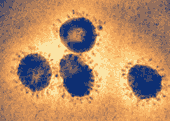
| Coronavirus | ||||||||
|---|---|---|---|---|---|---|---|---|
| Virus classification | ||||||||
|
Coronavirus
Coronavirus is a genus of animal virus belonging to the family Coronaviridae. Coronaviruses are enveloped viruses with a positive-sense single-stranded RNA genome and a helical symmetry. The genomic size of coronaviruses ranges from approximately 16 to 30 kb. The name coronavirus draws reference to the corona -- the ring-like radiating structure formed by the outermost part of the atmosphere of the sun. When observed under electron microscopy (E.M.), coronavirus particles exhibit a characteristic corona-like morphology. The corona-like structures are actually formed by the viral spike (S) peplomers, which are proteins that populate the surface of the virus and determine host tropism.
Proteins that contribute to the overall structure of all coronaviruses are the spike (S), envelope (E), membrane (M) and nucleocapsid (N). In the specific case of SARS (see below), a defined receptor-binding domain on S mediates the attachment of the virus to its cellular receptor, angiotensin-converting enzyme 2 (ACE2).[1]
Diseases of coronavirus
Coronaviruses primarily infect the upper respiratory and gastrointestinal tract. Four to five of total isolated strains of coronaviruses infect humans. The most publized human coronavirus, SARS-CoV, has a unique pathogenesis because it causes both upper and lower respiratory tract infections and can also cause gastroenteritis. Coronaviruses are believed to cause a significant percentage of all common colds in human adults. Coronaviruses cause colds in humans primarily in the winter and early spring seasons. The significance of coronaviruses as causative agents is hard to assess because, unlike rhinoviruses (another common cold virus), coronaviruses are difficult to grow in the laboratory.
Coronaviruses also cause a range of diseases in farm animals and domesticated pets, some of which can be serious and are a threat to the farming industry. Economically significant coronaviruses of farm animals include porcine coronavirus (transmissible gastroenteritis, TGE) and bovine coronavirus, which both result in diarrhea in young animals. Feline enteric coronavirus is a pathogen of minor clinical significance, but spontaneous mutation of this virus can result in feline infectious peritonitis (FIP), a disease associated with high mortality. Hence significant research efforts have been focused on elucidating the viral pathogenesis of these animal coronaviruses, especially by virologists interested in veterinary and zoonotic diseases.
SARS
In 2003, following the outbreak of Severe Acute Respiratory Syndrome which had begun the prior year (SARS) in Asia, and secondary cases elsewhere in the world, the World Health Organization issued a press release stating that a novel coronavirus identified by a number of laboratories was the causative agent for SARS. The virus was officially named the SARS coronavirus (SARS-CoV).
The SARS epidemic resulted in over 8000 infections, about 10% of which resulted in death.[2] X-ray crystallography studies performed at the Advanced Light Source of Lawrence Berkeley National Laboratory have begun to give hope of a vaccine against the disease since [the spike protein] appears to be recognized by the immune system of the host. [3]
Recent discoveries of novel human coronaviruses
Following the high-profile publicity of SARS outbreaks, there has been a renewed interest in coronaviruses in the field of virology. For many years, scientists know only about the existence of two human coronaviruses (HCoV-229E and HCoV-OC43). The discovery of SARS-CoV added another human coronavirus to the list. By the end of 2004, three independent research labs reported the discovery of a fourth human coronavirus. It has been named NL63, NL or the New Haven coronavirus by the different research groups. The naming of this fourth coronavirus is still a controversial issue, because the three labs are still battling over who actually discovered the virus first and hence earns the right to name the virus. Early in 2005, a research team at the University of Hong Kong reported finding a fifth human coronavirus in two pneumonia patients, and subsequently named it HKU1.
Species
- Genus Coronavirus
- Group 1
- Canine coronavirus (CCV)
- Feline coronavirus (FIPV)
- Human coronavirus 229E (HCoV-229E)
- Porcine epidemic diarrhea virus (PEDV)
- Transmissible gastroenteritis virus (TGEV)
- Human Coronavirus NL63 (NL or New Haven)
- Group 2
- Bovine coronavirus (BCoV)
- Human coronavirus OC43 (HCoV-OC43)
- Murine hepatitis virus (MHV)
- Porcine hemagglutinating encephalomyelitis virus (HEV)
- Rat coronavirus (RCV)
- Turkey coronavirus (TCoV)
- (No common name as of yet) (HCoV-HKU1)
- Group 3
- Infectious bronchitis virus (IBV)
- Not grouped
- Severe acute respiratory syndrome coronavirus (SARS-CoV)
- Group 1
Note: As of March 2005, most virologists who study coronaviruses would classify SARS-CoV as under Group 2 or as closely related to Group 2 coronaviruses.
References
- ^ Li, Fang, et. al. (2005). Structure of SARS Coronavirus Spike Receptor-Binding Domain Complexed with Receptor. Science 309: 1864–1868.
- ^ Learning How SARS Spikes Its Quarry. Press Release PR-HHMI-05-4. Chevy Chase, MD: Howard Hughes Medical Institute. URL accessed on September 16, 2005.
- van der Hoek L, Pyrc K, Jebbink MF, Vermeulen-Oost W, Berkhout RJ, Wolthers KC, Wertheim-van Dillen PM, Kaandorp J, Spaargaren J, Berkhout B. Identification of a new human coronavirus. Nat Med. 2004 Apr;10(4):368-73. Epub 2004 Mar 21.
External links
- Article on Coronaviruses
- Pictures of coronaviruses
- WHO press release identifying and naming the SARS virus
- Human coronaviruses and identification of unknown human pathogens
